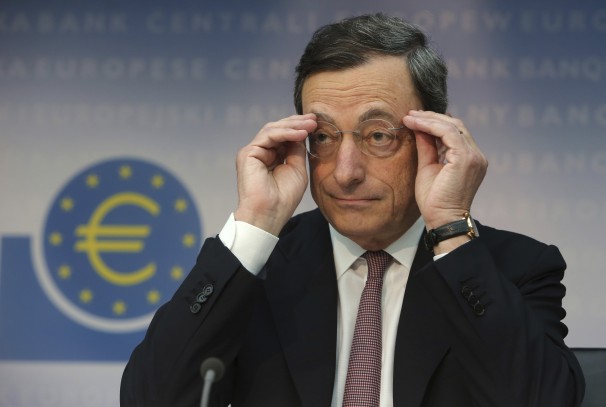
New Science Europe head questions centralized approach to research
June 7, 2014
Le Pen says EU ‘catastrophic’ foreign policy is controlled by US
June 7, 2014 
Mario Draghi is president of the European Central Bank. (Hannelore Foerster/Bloomberg)
The European Central Bank is now doing everything short of quantitative easing to belatedly try to stop the continent’s slow slide toward a Japanese-style lost decade — or worse.
After hinting that it was prepared to take bold, or at least some, action in the face of still-rising unemployment and still-falling inflation, the ECB unveiled a trio of new measures at its June meeting:
- First, it cut interest rates about as much as they can be cut. Specifically, it lowered its main refinancing rate from 0.25 percent to 0.15 percent, and the rate it pays on bank deposits from 0 to negative 0.1 percent. That’s right, it’s now charging banks to hold money with them overnight.
- Second, it announced a long-term lending program of as much as €400 billion (about $545 billion) to try to get credit to the households and businesses that need it (although these funds can’t be used for mortgages).
- And third, it will stop “sterilizing,” or offsetting, its bond-buying by draining out as much money as those purchases put in.
This wasn’t QE, but it was just about everything else — and, besides, the bank hinted that QE is next. ECB President Mario Draghi said Thursday that the central bank was doing the “preparatory” work for large-scale purchases if inflation, which was just 0.5 percent in May, stays so far below their close-to-2-percent target.
But why, seven years after the financial crisis hit, do they need more time for planning? Well, northern Europe doesn’t want the ECB to buy government bonds — the easiest thing it could do — because they think it would just be a bailout for southern Europe. So the ECB will have to buy private-sector bonds instead, even though there aren’t as many of them in Europe as in the United States.
Markets, at least, were happy enough with the steps the ECB did take. But how long they’ll stay happy will depend on how much these new measures actually help get Europe out of its “lowflation” trap. The negative interest rate on deposits should be the most powerful of them.
As Lars Svensson, a former central banker in Sweden and one of the top monetary economists in the world, told me, “Showing that zero isn’t the lower bound may have some additional demonstration effect.” In other words, it shows there’s more the ECB can do, and that it’s willing to push the boundaries, albeit after a good deal of political wrangling.
The euro zone is actually following Sweden and Denmark’s lead here. Both of them introduced penalty rates in the past few years, though in practice, the rates didn’t apply to many holdings. The idea now is to keep banks from moving more money into Europe, which should weaken the euro — and increase inflation a bit. It might also, though this is less certain, get banks who don’t want to pay the ECB for not lending to actually start lending.
But, as usual, the ECB might be doing too little, years too late. Charging banks to park cash at the ECB would have helped more back when banks actually had lots of cash parked at the ECB. As you can see in the chart below, banks have around €100 billion on deposit at the ECB today; down from almost €800 billion a few years ago.

Still, the ECB is doing about as much as the northern Europeans will let it. Draghi has to keep figuring out how to get them to do even more—or Europe will keep turning Japanese.

